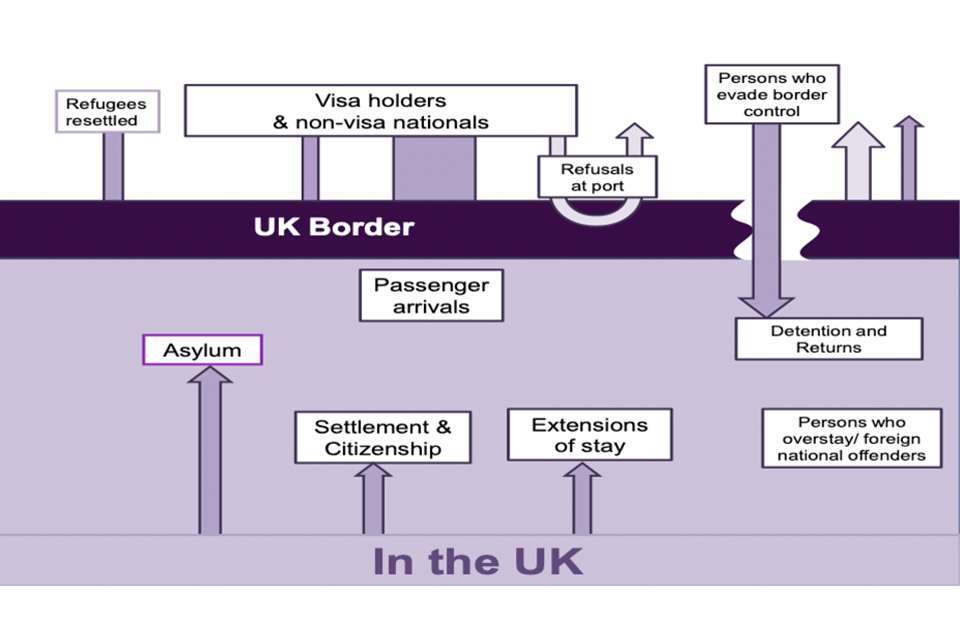Overview of the immigration system
Updated 27 November 2020
Back to ‘Immigration statistics, year ending September 2020’ content page.
This is not the latest release. View latest release.
The Home Office ‘Immigration statistics’ series forms part of a larger cross-Government Statistical Service Transformation plan to meet changing user needs, and which will begin to put administrative data at the core of evidence on migration.
‘Immigration statistics, year ending September 2020’ provides the latest figures on persons who are subject to United Kingdom (UK) immigration controls. All data in this release relate to the year ending September 2020 (1 October 2019 to 30 September 2020) and all comparisons are with the year ending September 2019 (1 October 2018 to 30 September 2019), unless stated otherwise. Due to European Union (EU) freedom of movement principles, the majority of UK immigration controls relate to non-European Economic Area (EEA) nationals. Unless otherwise stated, data in this release relate to non-EEA nationals.
The Immigration statistics release provides information on the Home Office’s operation of immigration control and related processes, including the work of UK Border Force, UK Visas and Immigration (UKVI), and Immigration Enforcement.
Figures on performance against service standards and processing times are published as part of the Home Office ‘Migration transparency data’.
The Home Office publishes a range of other research on migration, available at the ‘Migration research and analysis’ page on GOV.UK. Details on the developments and future plans for Home Office Immigration statistics can be found in ‘Developments in migration statistics’. For details of other migration outputs published across government, see the ‘About this release’ section.
Figure 1 provides a high-level overview of UK immigration control for non-EEA nationals. It does not include reference to all aspects of immigration as highlighted in the chart notes.
The impact of COVID-19
On 11 March 2020, the World Health Organisation (WHO) declared the COVID-19 outbreak as a global pandemic. A range of restrictions relating to the outbreak began on 12 March 2020, the Foreign and Commonwealth Office (FCO) advised against all non-essential overseas travel on 17 March 2020, and advised all British travellers to return to the UK on 23 March 2020, the same day as the first UK lockdown measures were announced.
Restrictions were put in place across Europe and other parts of the world in the run up to the UK outbreak, which will also have impacted travel to the UK prior to these dates. The COVID-19 pandemic has had a significant impact on the UK immigration system, both in terms of restricting migrant movements to and from the UK and the impact on operational capacity.
Year ending comparisons that follow will reflect the restrictions in place during this period of the pandemic.
An additional one-off report, Statistics relating to Covid-19 and the immigration system, May 2020, was published on 28 May 2020, providing a statistical overview of COVID-19 impacts on the immigration system through to the end of April 2020. The information in this additional report was designed to provide an overview of the key impacts on the immigration system of the outbreak of COVID-19 in the UK and the introduction of lockdown measures in March and April 2020. Statistics relating to passenger arrivals since the COVID-19 outbreak have been updated to show more detailed information (including daily figures) relating to passengers arriving into the UK by air between January to October 2020.
Figure 1: Summary of UK immigration system1,2

Chart notes:
- The chart excludes references to appeals.
- Non-visa nationals seeking to enter the UK in a visa category for longer than 6 months require a visa, whereas those seeking to enter the UK for 6 months or less do not.
Other statistical releases
At the same time as this release, the following statistical releases were also published:
- ‘International migration since the coronavirus (COVID-19) pandemic’ - A migration synthesis report bringing together a range of data sources on international migration and mobility patterns since the coronavirus pandemic
- ‘Population and migration statistics system transformation – overview’ - An article providing information on our latest progress with the development of admin-based migration estimates (ABMEs) and alternative approaches for estimating migration for the period April to June 2020
- ‘Long-term international migration estimates: 2019’ – a set of data tables providing final annual data for 2019 based on the IPS
- ‘EU Settlement Scheme Statistics, Quarterly Statistics’, Home Office
- ‘Statistics relating to passenger arrivals since the COVID-19 outbreak, November 2020’ - A statistical report showing the impact of COVID-19 on the immigration system, up to October 2020.
- ‘Work and Health Programme statistics to August 2020’ Quarterly experimental Official Statistics release of Work and Health Programme data.
- ‘National insurance numbers allocations to adult overseas nationals entering the UK to September 2020’, Department for Work and Pensions (DWP) Quarterly Official Statistics on National Insurance number allocations to adult overseas nationals entering the UK.
We welcome your feedback
If you have any comments or suggestions for the development of this report, please provide feedback by emailing MigrationStatsEnquiries@homeoffice.gov.uk. Please include the words ‘PUBLICATION FEEDBACK’ in the subject of your email.
We’re always looking to improve the accessibility of our documents. If you find any problems or have any feedback relating to accessibility, please email us.
See section 7 of the ‘About this release’ section for more details.
